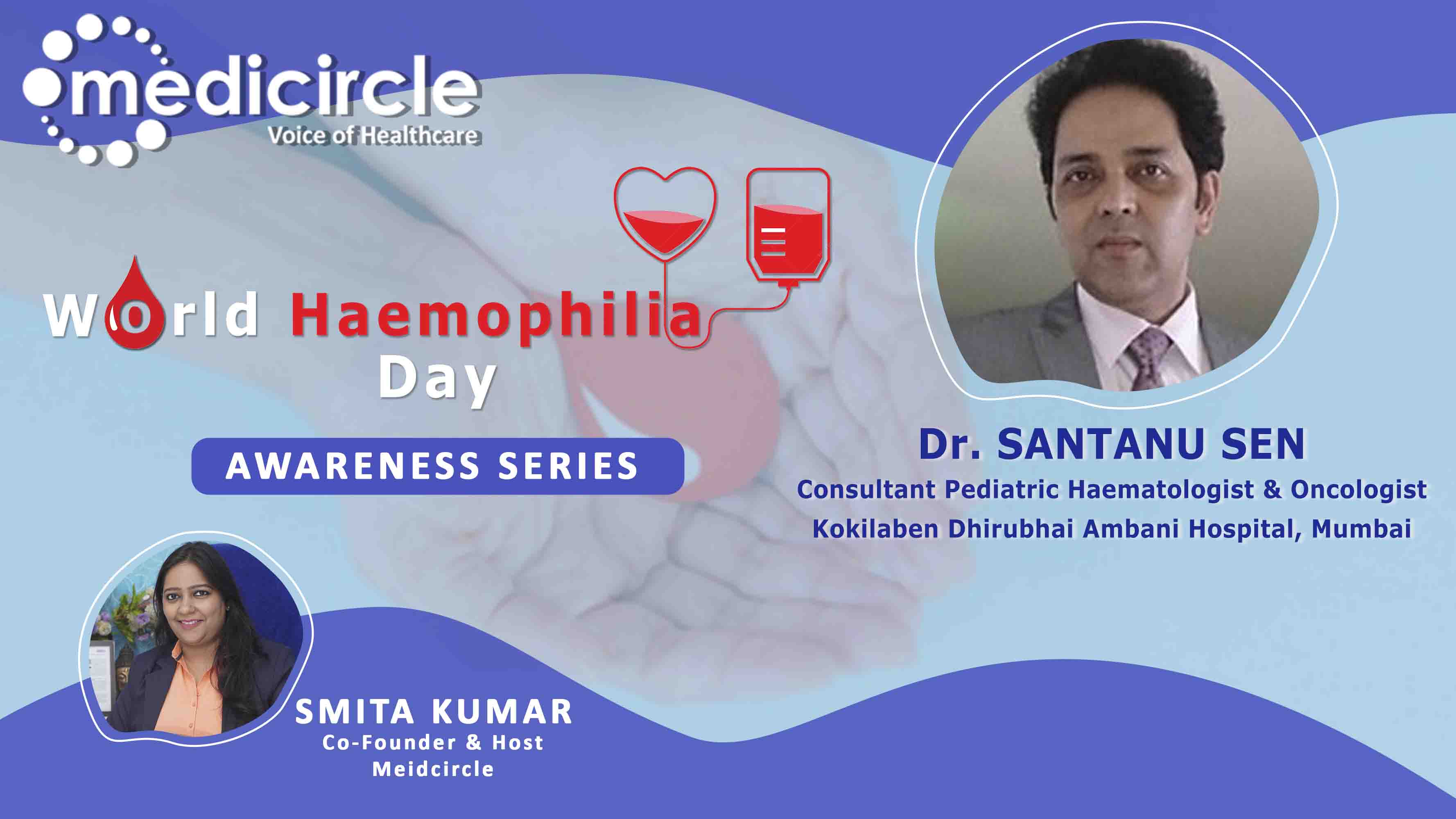Haemophilia is a rare disorder in which your blood doesn't clot normally because it lacks sufficient blood clotting proteins known as clotting factors. This results in prolonged bleeding. In such cases, it is important to take necessary precautions. On this World Haemophilia Day, we at Medicircle are speaking to eminent Doctors and Haematologist to create awareness about Haemophilia disorders and their necessary precautionary measures.
Dr. Santanu Sen is a Pediatric Oncologist with extensive experience of working with children with various cancers and blood disorders and BMT for over 12 years in the UK. He is the Head of Pediatric Oncology, Haematology, and BMT in Kokilaben Hospital for the last 12 years. He has worked at the Royal Marsden Hospital in London treating children with cancer. He has specialties in BMT, Pediatric blood disorder, and all Pediatric cancers.
All about Clotting Factors
Dr. Santanu says, “Whenever we get an injury, bleeding usually comes. After putting pressure, bleeding generally stops in 2 to 3 minutes. There is a protein in our blood, which is called a clotting factor. These clotting factors vary from I to XIII, they help in the blood clotting in case of any injury and stops bleeding. The same process regulates in every part of our body.”
Haemophilia A is very common
Dr. Santanu shares, “Haemophilia is generally considered of two types – Haemophilia A and Haemophilia B. Haemophilia A is very common, unlike Haemophilia B which is rare. Haemophilia A is due to deficiency or improper proportion of clotting factor VIII whereas Haemophilia B is due to deficiency of clotting factor IX. There are 70,000 known patients of haemophilia A & B in our country.”
Haemophilia is seen more in males than females
Dr. Santanu explains, “It is a genetic disease that means it comes from parents to the offspring. It is localized in X chromosomes and is rampant in males than females. Females have ‘2X’ chromosomes while males have ‘X’ & ‘Y’. If ‘X’ chromosomes get hampered or defected or injured, the other ‘X’ chromosome can produce enough clotting factor in case of females. In males there is no second ‘X’, thus it can be problematic. If the same female delivers a boy and a defective ‘X’ chromosome passes onto him, the boy will be deficient in clotting factor because of that defective ‘X’ chromosome. Hence it is seen that 90-95% of Haemophilia patients are males and only a few are females. There is 1 in 10000 haemophilia A male and 1 in 30000 haemophilia B patients.”
Dr. Santanu expresses, “If an individual knows that they have a family history of haemophilia, the family should be little prepared for it. New cases of Haemophilia are generally because of a new mutation. In haemophilia patients, bleeding doesn’t stop even after minor circumstantial or vaccination procedure also. If any child is having excessive bleeding due to any injury, tooth extraction, or gets a wound after vaccination, is a sign of developing haemophilia.”
Actual haemophilia patients are ten times more than in records
Dr. Santanu mentions, “India has the second highest haemophilia patient after the US in the world. These numbers are as per the data which are recorded or diagnosed. Probably the patients are 10 times more than the number in records. These patients don’t get noticed or diagnosed because they are from remote areas where they have inadequate medical attention. Thus, they don’t come in our awareness or reach.”
Clotting Factor Assay
Dr. Santanu informs, “Haemophilia is diagnosed through a special test called Clotting Factor Assay. This test is performed to check the amount of clotting factor present. The severity of the disease depends upon the level of clotting factor. The disease can be categorized as -
Mild – Clotting factor is 5 – 40%
Moderate – Clotting factor is 1 – 5%
Severe – Clotting factor is less than 1%.
It’s very unfortunate that 70 – 80% of Indians are categorized under severe haemophilia. Diagnosing facilities are available only in metro cities and not in remote areas.”
Dr. Santanu adds, “Basically, doctors perform tests for haemophilia before any major operation. Even for minor procedures like circumcision and tooth extraction, sometimes haemophilia patients end up with a lot of trouble managing the bleed.”
NGO’s provide clotting factor injections at a reduced cost
Dr. Santanu talks, “Treatment includes providing clotting factor from outside. Taking any medicine or any prophylactic treatment is not going to help here. Giving a clotting factor is the only solution. If there is a deficiency of clotting factor it has to be replaced by providing adequate clotting factor, then only the bleeding will stop.”
Dr. Santanu elaborates, “Clotting factor is separated from blood and comes in the form of injection, but these injections are very expensive. Those in need of these injections can approach Government NGOs and National Haemophilia Society and can get them at a reduced cost. These are available in markets also. They come with distilled water, you have to mix them and take it in the form of injection.”
Untreated haemophilia can result in severe complications
Dr. Santanu speaks, “In India, 90% of affected individuals can’t keep a stock of it as a prophylactic treatment for emergencies because of its expensive cost. Basically, we treat them as and when needed. Parents know that if anything like this happens, they have to go to the hospital and get infused with clotting factors otherwise bleeding won’t stop. Delayed treatment could result in severe complications. For example, if a patient’s joints get injured and are not treated timely, joints can get dysfunctional due to excessive bleeding. There will not be any movement through joints. They will never get back to their normal condition for life long.”
(Edited by - Renu Gupta)

 “Haemophilia is prominent more in males than females. Patients with haemophilia are 10 times more than the numbers in records. These unnoticed patients don’t get diagnosed because they are from remote areas where they have inadequate medical attention†Dr. Santanu Sen, Pediatric Haematologist and Oncologist, Kokilaben hospital
“Haemophilia is prominent more in males than females. Patients with haemophilia are 10 times more than the numbers in records. These unnoticed patients don’t get diagnosed because they are from remote areas where they have inadequate medical attention†Dr. Santanu Sen, Pediatric Haematologist and Oncologist, Kokilaben hospital








.jpeg)



.jpg)







.jpeg)

.jpg)




.jpg)




.png)


